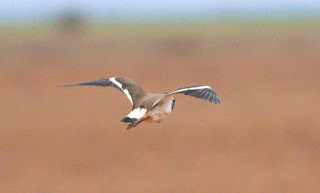 |
| Letter-winged Kite |
Following our travels through Longreach, Winton and Mt Isa (following post) we headed south from Mt Isa to Boulia, with rain dashing hopes for further stops for Kalkadoon Grasswren. It had eased by the time we got to Boulia. Continuing south to Bedourie, the Mitchell grass and gibber plains were a sight to behold: a glorious mosaic of wildflowers, vivid greenery, extensive pools of water and lush vegetation in every direction. The bothersome rains that were reshaping our travel plans had a silver lining.
Not far south of Boulia we located a Letter-winged Kite colony that had been reported earlier. These rare birds, under threat from feral cats, are pure pleasure. We had about 12 adults and immatures soaring high and sometimes low above us, mixing with Black Kites and other raptors. In a line of trees along a small watercourse, a pair of Letter-winged Kites held vigil over a nest containing two well-fledged youngsters. Several nests were present in other trees.
A little further south we had a good-sized grouping of Flock Bronzewings (below) feeding by the roadside. We had encountered this species in singles, pairs and smaller flocks on several occasions earlier - a much higher score rate than is usual in these parts. We were to see quite a few more further south and on our return home.
As we drove south, Australian Pratincoles were everywhere, often sitting on the road. Again, we had seen fair numbers earlier and sightings overall were well above the norm for this species. A few Banded Lapwings were about.
 |
| Banded Lapwing |
 |
| Australian Pratincole |
 |
| Australian Pratincole |
Brolga and Australian Bustard were also in good numbers.
We headed south from Bedourie after an overnight stay to Cuttaburra Crossing. We searched the extensive areas of lignum here for Grey Grasswren, locating at least 6 birds. Although everyone managed a glimpse, no images were captured. The going was tough, with water and mud in abundance through the lignum.
Australian Spotted Crake and Black-tailed Native-hen were common in the lignum, and several Long-haired Rats were scurrying about in broad daylight.
 |
| Black-tailed Native-hen |
 |
| Australian Spotted Crake |
The number of waterbirds overall was staggering. At a river crossing not far south of Bedourie, about 300 Nankeen Night-Herons (below) were feeding and roosting. An estimated 90 per cent were immatures. None of us had seen the species in anywhere near those numbers previously.
At Cuttaburra Crossing, waterbirds were in large numbers all over the place. A very rough estimate of 2500 Whiskered Terns in various plumage stages was a sight to behold.
 |
| Whiskered Tern |
Australian (Gull-billed) Terns, Glossy Ibis and Grey Teal were among the species that were present in their hundreds or thousands. Strangely absent were Pink-eared and Freckled Ducks.
 |
| Glossy Ibis |
 |
| Yellow-billed Spoonbill |
One odd-looking bird had us wondering if we were watching a White-faced Heron-Little Egret hybrid (bird on the right below) but most likely it was a leucistic juvenile White-faced Heron.








































